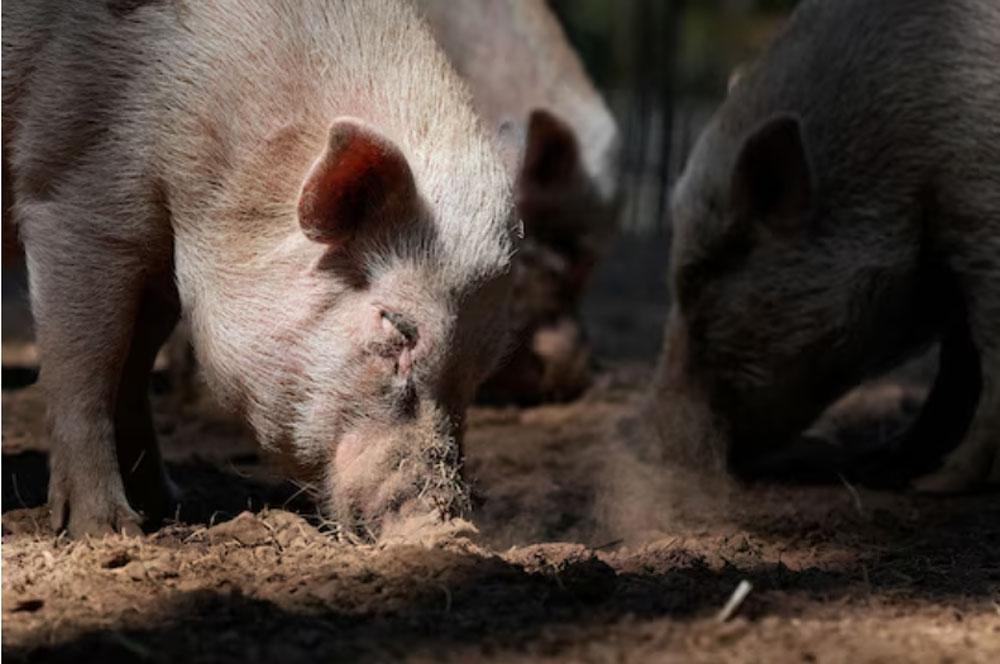Reply To:
Name - Reply Comment
 Washington Post - Bird flu has been found in at least one pig at a backyard farm in Oregon, the first detection of the H5N1 virus in swine in the United States, the U.S. Agriculture Department said Wednesday.
Washington Post - Bird flu has been found in at least one pig at a backyard farm in Oregon, the first detection of the H5N1 virus in swine in the United States, the U.S. Agriculture Department said Wednesday.
The discovery is particularly concerning to scientists and public health officials because pigs can become coinfected with bird and human viruses, allowing genes to swap to form a new, more dangerous virus that can more easily infect humans.
Bird flu was first detected in poultry on the noncommercial farm, the Oregon agriculture department said Friday. State and federal agriculture authorities euthanized 70 of the infected backyard birds last week to prevent the further spread of virus, the department said. The USDA’s National Veterinary Services Laboratories confirmed that one of the farm’s five pigs was infected with the virus on Tuesday but did not publicize the discovery until Wednesday.
Preliminary genetic sequencing has linked the virus found in poultry to migratory birds, according to a federal official who spoke on the condition of anonymity because the investigation is ongoing. It is not the same H5N1 strain that has been spreading in dairy cows since the spring, which has sickened at least 31 people — all with mild symptoms.
Genetic analysis of the virus in the pig is underway.
The agency did not say how the animal became infected. Livestock and poultry on the farm shared water sources, housing and equipment — a combination that has enabled transmission between species in other states, according to USDA. Another potential pathway for transmission could be from eating an infected bird, said Cathy Cochran, USDA’s director of communications.
State and federal officials said the swine did not display signs of illness. State and federal officials tested the five pigs for H5N1 out of an abundance of caution and because of the presence of H5N1 in other animals on the premises. Two pigs have tested negative, and test results are pending for two others, the USDA said. The swine were euthanized to facilitate additional diagnostic analysis, according to the agency.
Other animals on the farm, including sheep and goats, remain under surveillance. The farm has been quarantined to prevent further spread of the virus, the USDA said.
Public health experts have been worried about the virus jumping to pigs since the outbreak was detected in U.S. dairy cattle this past spring.
“Pigs are very concerning because the virus can adapt” inside the pig, said Katelyn Jetelina, an infectious-disease specialist who has been following the outbreak. “They’re mixing vessels. That’s why we’re nervous, but we have a lot of questions.”
Pigs are one of the few animals in which an avian virus can replicate to become more like a human virus, said Richard Webby, a St. Jude Children’s Research Hospital virologist who studies flu in birds and other animals for the World Health Organization. Pigs were the source of the H1N1 flu pandemic in 2009-2010.
Once an avian virus like H5N1 gets into a pig, it can mix with other viruses — a process known as reassortment — and pick up the ability to grow better and adapt to make humans sicker, Webby said.
Animals on the farm are not part of the commercial food supply, the USDA said. The discovery of bird flu in the swine has no impact on the safety of the nation’s pork supply.
The farm’s small size gives the virus less opportunity to spill into humans, experts said.
Genomic sequencing of the H5N1 virus found in the farm’s infected poultry has not identified any changes that would suggest it is more transmissible to humans, according to USDA and the Centers for Disease Control and Prevention, indicating that the current risk to the public remains low.
“There are a lot of questions that have to be answered before we can draw any firm conclusions about what’s happened here,” said Michael Osterholm, who leads the University of Minnesota’s Center for Infectious Disease Research and Policy.